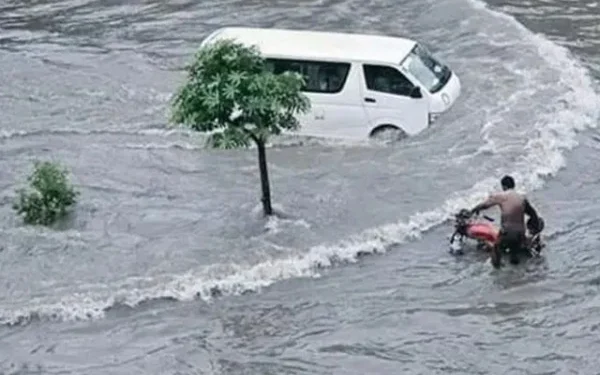Islamabad, Torrential monsoon rains continue to devastate large parts of Pakistan, triggering widespread flooding, house collapses, and fatal accidents. According to the latest situation report issued by the National Disaster Management Authority (NDMA), the relentless downpour has claimed the lives of 221 people, injured hundreds more, and left a trail of destruction across all provinces, including the capital territory.
The NDMA’s report presents a grim picture of the human, material, and agricultural toll caused by the ongoing weather emergency. As monsoon season peaks, the figures are expected to rise, further straining the country’s already fragile disaster response infrastructure.
Human Toll Reaches 221 Deaths Nationwide
The most distressing revelation from the NDMA report is the steep human cost. As of the latest updates, 221 people have lost their lives in rain-related incidents, which include house collapses, landslides, lightning strikes, flash floods, and electrocution.
The casualties span across all regions of the country, with Punjab province suffering the heaviest loss of life.
Province-Wise Breakdown of Fatalities and Injuries
Punjab – Worst-Hit Region
- Deaths: 135
- Injured: 470
- Houses partially damaged: 168
- Houses completely destroyed: 24
Punjab has been the epicenter of this monsoon disaster. Cities like Lahore, Multan, Rawalpindi, and Faisalabad experienced record-breaking rainfalls that overwhelmed urban drainage systems. Many fatalities occurred due to collapsed buildings, drowning in low-lying areas, and electrical accidents caused by exposed wiring and downed power lines.
Khyber Pakhtunkhwa (KP)
- Deaths: 40
- Injured: 69
- Houses partially damaged: 142
- Houses completely destroyed: 78
The mountainous terrain of KP makes it particularly vulnerable to landslides and flash floods. Swat, Chitral, and Kohistan witnessed houses swept away by torrents, with rescue workers facing difficulties due to damaged roads and blocked access routes.
Sindh
- Deaths: 22
- Injured: 40
- Houses partially damaged: 54
- Houses completely destroyed: 33
In Sindh, Karachi, Hyderabad, and interior districts saw heavy flooding, with low-income neighborhoods submerged. Most deaths were attributed to structural collapses, particularly in informal settlements built with substandard materials.
Balochistan
- Deaths: 16
- Injured: 4
- Houses partially damaged: 56
- Houses completely destroyed: 8
Balochistan, despite having a more arid climate, was not spared. In districts like Turbat and Quetta, seasonal streams turned violent, damaging homes and cutting off entire communities.
Gilgit-Baltistan
- Injured: 3
- Houses partially damaged: 71
- Houses completely destroyed: 66
In this northern region, fragile mud and stone houses could not withstand the continuous rainfall. Several villages remain isolated due to damaged roads, raising fears of further casualties.
Azad Jammu and Kashmir (AJK)
- Deaths: 1
- Injured: 6
- Houses partially damaged: 75
- Houses completely destroyed: 17
Although AJK experienced fewer fatalities, property damage has been significant. Landslides and falling trees added to the destruction in Muzaffarabad and surrounding areas.
Islamabad Capital Territory
- Deaths: 1
- Houses partially damaged: 35
- House completely destroyed: 1
Even the nation’s capital has not been spared, where urban flooding disrupted traffic and inundated residential areas. One person lost their life in a house collapse incident in G-7 sector, highlighting poor building resilience even in urban centers.
Widespread Structural Damage: Over 800 Homes Destroyed
According to NDMA’s data, 804 homes have been completely destroyed, while hundreds more have sustained partial damage. These homes, largely belonging to low-income families in rural or peri-urban areas, were made from non-durable materials like mud and bricks.
As per the latest damage assessment:
- Most of the completely destroyed homes were reported from KP, Punjab, and Gilgit-Baltistan.
- Families have been displaced, taking refuge in temporary shelters, government buildings, or with relatives.
The rehabilitation process is expected to be long and arduous, especially in remote regions where access remains limited due to damaged roads and collapsed bridges.
Livestock and Agricultural Losses
The report also highlights significant losses to livestock and agriculture, further exacerbating the humanitarian crisis.
- Livestock deaths: 200
- In the last 24 hours alone: 5 livestock died, along with 5 new fatalities and 25 additional houses collapsing.
Livestock is a vital economic asset for many rural families, and these losses represent a devastating blow to their livelihoods. In areas like Southern Punjab and Balochistan, entire herds were swept away by flash floods.
Crop damage is yet to be fully assessed, but preliminary reports suggest:
- Rice and cotton crops have suffered severe damage.
- Irrigation canals and water channels have been choked or overflown.
- Food insecurity may rise in affected regions if supply chains are not quickly restored.
Government and NDMA Response
The NDMA, in collaboration with provincial disaster management authorities (PDMAs) and the armed forces, has initiated emergency rescue and relief operations in the most affected districts. Key steps taken include:
- Evacuation operations using helicopters and boats
- Medical camps set up for the injured
- Relief camps providing temporary shelter, food, and clean drinking water
- Distribution of hygiene kits, especially in areas prone to waterborne diseases
- Mobile health teams deployed to prevent disease outbreaks
In a public statement, NDMA Chairman Lt. Gen. Inam Haider Malik assured that all available resources were being mobilized to save lives, restore infrastructure, and rehabilitate displaced populations.
Calls for Climate Resilience and Urban Planning Reform
This disaster has once again brought attention to Pakistan’s vulnerability to climate change and the urgent need for resilience-building.
Urban Flooding
In major cities like Lahore and Karachi, rainwater accumulated for hours due to clogged drains and poorly managed urban infrastructure. Experts have urged:
- Modern stormwater drainage systems
- Green urban planning
- Reconstruction of canals and water storage systems
Climate Adaptation
Environmentalists are pressing for long-term adaptation strategies as erratic weather patterns, intensified monsoons, and rising temperatures become more common. Pakistan has ranked consistently among the top 10 countries most affected by climate change, according to the Global Climate Risk Index.
Relief Efforts and Public Assistance
NDMA and provincial governments have appealed to citizens and the private sector for support. Relief donations are being accepted through official portals and registered NGOs. Medical supplies, tents, dry food, and clean water remain top priorities.
Citizens are also encouraged to:
- Avoid unnecessary travel in flood-affected areas
- Report structural vulnerabilities in buildings
- Follow early warning systems and NDMA updates via SMS and media
Conclusion: A National Emergency Requiring United Action
As the death toll rises and damages mount, Pakistan faces one of its most severe monsoon disasters in recent years. The NDMA’s latest report not only highlights the immediate destruction caused by heavy rains but also serves as a warning of structural and policy failures that must be urgently addressed.
While emergency operations are underway, the focus must now shift to rebuilding, strengthening resilience, and ensuring that vulnerable populations are not left behind. Pakistan’s government, civil society, and international partners must work together to turn this crisis into an opportunity to build back safer and better.

























